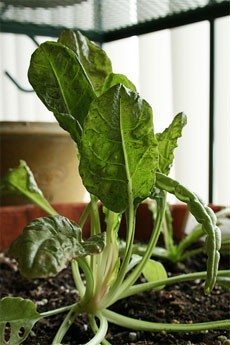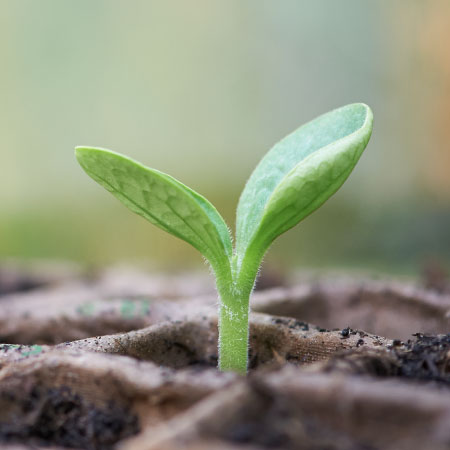Indoor Organic Gardening

Many people believe that because they live in a city apartment, they could never have an organic garden of their own. Nothing could be further from the truth because as long as you have several windows, you can grow a lot of produce. Indoor organic gardening in containers allows you to grow nearly anything your heart desires. Let's learn more about how to grow plants organically indoors.
Organic Container Gardening Indoors
Almost any vegetable can be grown in containers. Pots, hanging baskets, and numerous other containers can be used to grow vegetables, herbs, and flowers organically indoors. The key is to match the vegetable with the proper sized container. The larger the plant will be at maturity, the larger container you will need. Organic potting soil is available at any good garden center. Once you determine how much you will need for your available containers, make your purchase. Pre-packaged compost can be purchased at the same time to increase the nutrient value of the potting soil. At the same time, choose the vegetable plants and seeds that you wish to grow. Be sure to purchase only strong healthy plants, as they are the ones that will produce the best.
Tips for Indoor Organic Gardening
Give the plants a day or two in front of a sunny window before transplanting them to the containers. This will allow them to acclimate to their new environment. When you are ready to transplant, the following specifics can be a guide:
Vegetables
Tomato plants should be planted individually in pots no less than eight inches (20.5 cm.) in diameter. Plant deep enough that the roots are buried at least one inch (2.5 cm.) under the soil line. Place a stick or other rod along the side of the plant for tying the plant to as it grows. Set the container in front of a south-facing window and water whenever the soil feels dry to the touch. Bush beans can be planted directly from seed in containers of at least eight inches (20.5 cm.) in diameter. Runner beans and most peas can be planted in hanging baskets, where the plant can drape over the sides to the ground. While beans prefer the southern sun, they can also be placed in windows where they receive either the morning or evening light. Most types of leaf lettuce can be planted in almost any type of container. Read the package instructions of the individual species to determine how thick to plant the seed. Lettuce will do well in the morning sunlight. This method is not for the timid but does work well and makes for a wonderful conversation piece. Remove the curtains from a south-facing window, leaving the curtain rod in place. Hang a basket of single, same variety squash plants at either end of the window. As the squash grows, train the vines to cling to the curtain rod. By summer's end, you will have both squash to eat and a lovely, living curtain on the window. Growing corn indoors requires a very large container, but can be a striking addition to your indoor garden. Plant a handful of corn seed approximately one inch (2.5 cm.) deep scattered around the diameter of the container. Thin plants to no more than three to five plants once you determine which are the strongest. Keep the soil moist at all times and by the time it matures, you will have enough corn for at least several meals.
Herbs
Kitchen herbs such as oregano, thyme, basil, and rosemary can be planted together in a window box in the kitchen. Plant chives in a separate container that can be placed in the same window. If you have a window over the kitchen sink, this placement can work best, as the herbs will receive steam moisture from dishwashing. Use the herbs as needed and trim the leaves back to keep them from growing too large. For people who cannot find room at all for container gardening, sprouts can be the answer. Buy organic alfalfa, mung beans, or other sprouting seeds at your local health food store. Measure approximately one tablespoon (15 mL.) of seed into a quart jar and cover with a cloth or other fine screening. Use a screw band or rubber band to hold the cover on. Fill the jar half full with water and place it in a dark cabinet to sit overnight. Beginning the next morning, drain the sprouts and rinse them twice a day. Depending on the type of seed you are using, the spouts will be ready to eat in three to five days. Once they are at approximately the right size, set the jar in a window to allow them to green up. Organic container gardening can be fun and provide you with all different types of fresh vegetables and herbs. The taste will be fresher and the product healthier than what you can purchase at a regular grocery store. And the best part is that you can grow them year-round.
Gardening tips, videos, info and more delivered right to your inbox!
Sign up for the Gardening Know How newsletter today and receive a free copy of our e-book "How to Grow Delicious Tomatoes".

Kat Yares is a writer for Gardening Know How, specializing in organic gardening techniques.
-
 Get Ready For A Summer Of Hummers! Grow These Full Sun Hummingbird Plants and Flowers
Get Ready For A Summer Of Hummers! Grow These Full Sun Hummingbird Plants and FlowersIf you’re lucky enough to enjoy a sunny backyard, make sure you are maxing out on your pollinator opportunities and grow these full sun hummingbird plants and flowers
By Tonya Barnett
-
 12 Lush Alternatives To A Lawn For Sustainable Spaces
12 Lush Alternatives To A Lawn For Sustainable SpacesAlternatives to a lawn are beautiful and also beneficial to your local ecosystem and its pollinators. Explore our top picks for plants to replace grass.
By Tonya Barnett